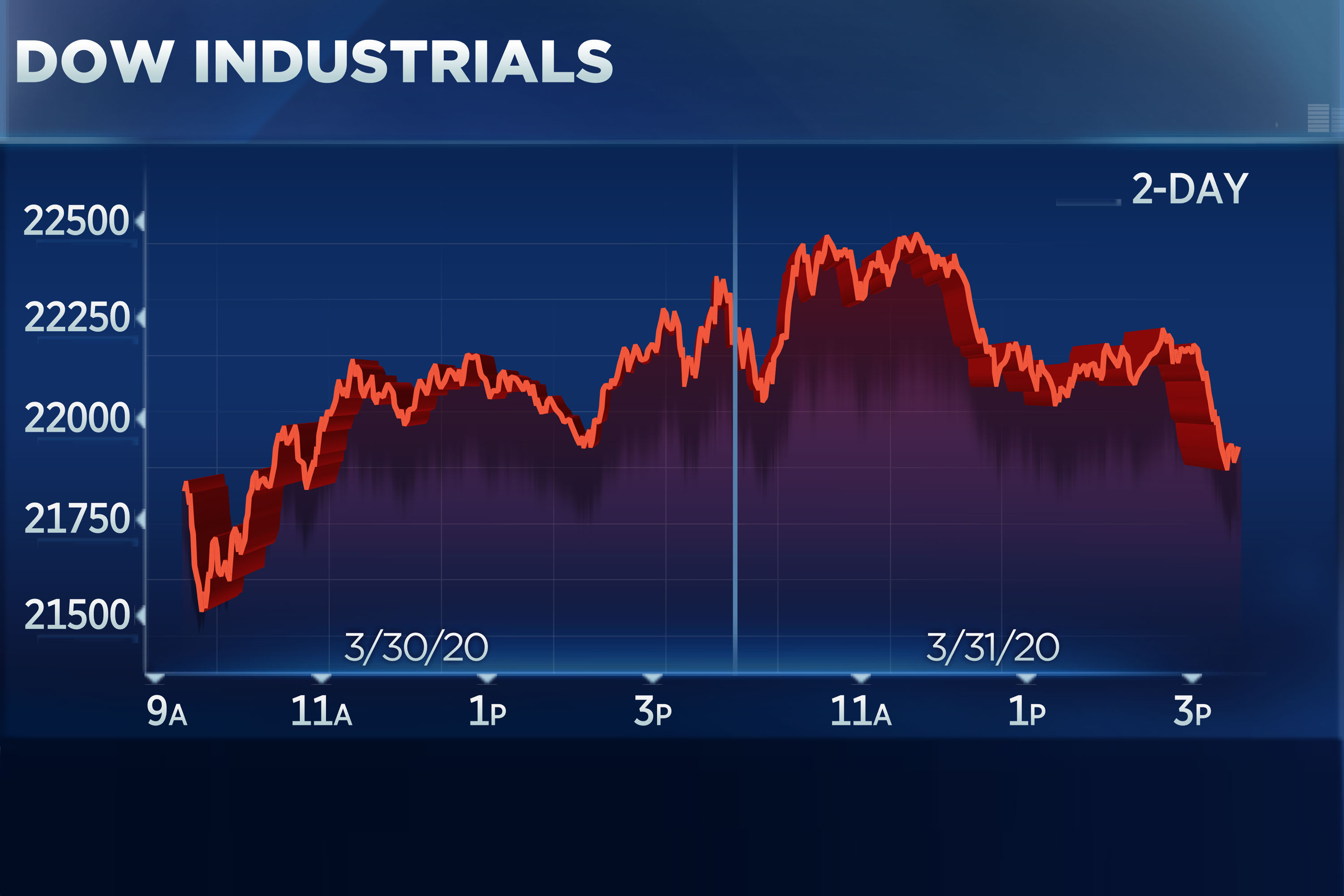
Stocks fell on Tuesday, the last day of the first quarter, as investors wrapped up a period of historic market volatility sparked by the coronavirus pandemic.
The Dow Jones Industrial Average traded 404 points lower, or 1.8%. The S&P 500 was down by 1.9%. The Nasdaq Composite fell 1.5%. The 30-stock benchmark was up as much as 152 points earlier in the day; it has fallen as much as 293.63 points, or 1.3%.
Investors digested a slew of news that may be contributing to the volatile swings on Tuesday, along with the monthly rebalancing of portfolios:
- Bank stock such as JPMorgan Chase, Citigroup and Bank of America. JPMorgan and Citi fell 2.6% and 3%, respectively, while Bank of America lost 1.7%.
- New York Gov. Andrew Cuomo said coronavirus cases in the state jumped by 14% overnight to more than 75,000.
- Goldman Sachs said that the economy would go through an unprecedented plunge in the second quarter, but that the recovery would then be the fastest in history.
- U.S. consumer confidence dropped less than expected in March. The Conference Board said Tuesday its consumer confidence index dropped to 120 this month from 132.6 in February, beating a Dow Jones estimate of 110.
- Dr. Anthony Fauci, director of the National Institute of Allergy and Infectious Diseases, told CNN that he is starting to see “glimmers” that social distancing is helping to lessen the spread of the coronavirus in the U.S.
The Dow was headed for its worst first-quarter performance ever, losing more than 22% of its value in the first three months of 2020. The S&P 500 is down 19.6% this quarter, the broader market index’s biggest quarterly losses since 2008. It was also headed for its worst first quarter since 1938.
Wall Street was also poised for sharp monthly losses. The Dow and S&P 500 are down more than 12% each in March.
To be sure, stocks have regained some ground since last week. The Dow has rallied more than 18% since reaching a low on March 23 while the S&P 500 has gained 16.1% since then. Part of those gains came on Monday, when the Dow jumped nearly 700 points after President Donald Trump extended the timeline for social distancing guidelines to April 30, which many believe will reduce economic damage in the long run.
“As we conclude an unforgettable March and 1st Quarter today, the market seemingly has drifted (spiked) to no man’s land,” wrote Frank Cappelleri, executive director at Instinet. He noted that stocks have rallied from their lows last week but are still well below their record highs. But, “for what it’s worth, April has a better track record on average (+1.7% the last two decades, with a 75% win rate). It, too, has tended to do better in the final two weeks.”
Stocks have managed to rally to end the month despite concerning economic data including last week’s record number of jobless claims and Monday’s worse-than-expected manufacturing reading from the Dallas Fed.
However, many on Wall Street are calling for even more selling before the market can hit a bottom. Historically, bear markets are often punctuated by sharp bounces on their way down to a trough.
“Last week’s double-digit gain for markets was a welcome relief rally, though market bottoms are rarely as clean as this one has been,” said Mark Hackett, Nationwide’s chief of investment research. “Markets will need to reflect more traditional interactions before confidence in a bottom can be reached.”
Investors continued to grapple with the worsening outbreak in the U.S. as the confirmed cases rose to more than 153,200, according to data from Johns Hopkins University. The U.S. has also officially become the country most affected. Trump said Sunday he hopes the country will “be well on our way to recovery” by June 1.
“It’s hard to envision the equity market trending higher without some visibility and the curve of new cases begins to flatten out,” said Terry Sandven, chief equity strategist at U.S. Bank Wealth Management. “Perhaps we’ll get some of those characteristics as you look through the earnings season.”
“We do not think this is going to be a V-shaped recovery; we think it’s more of a U-shaped recovery,” said Sandven. “The risk of a recession is still pretty high, and we’re likely to be in a recession right now.”
Subscribe to CNBC PRO for exclusive insights and analysis, and live business day programming from around the world.

